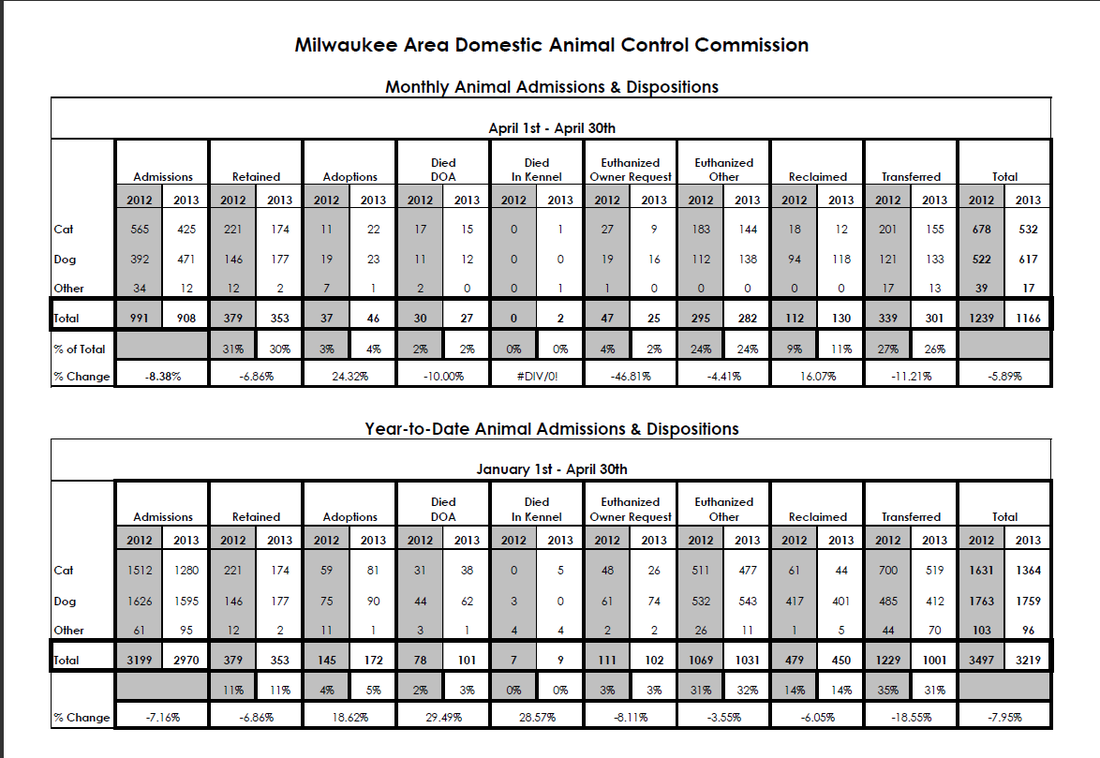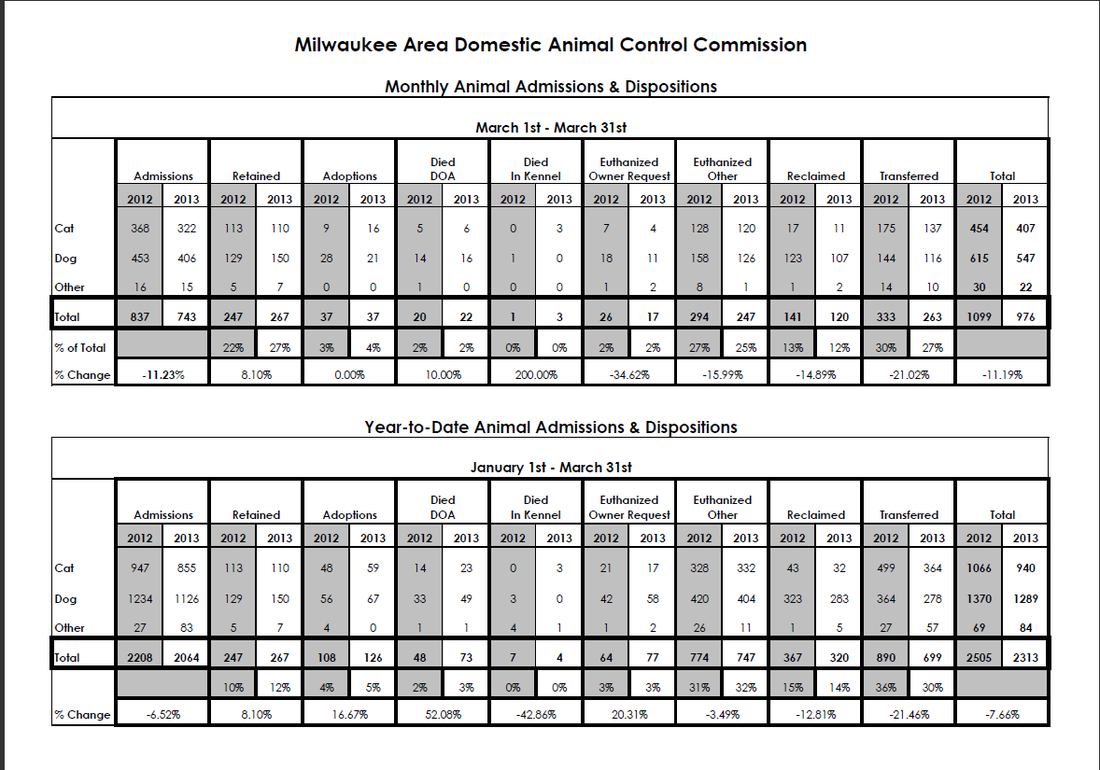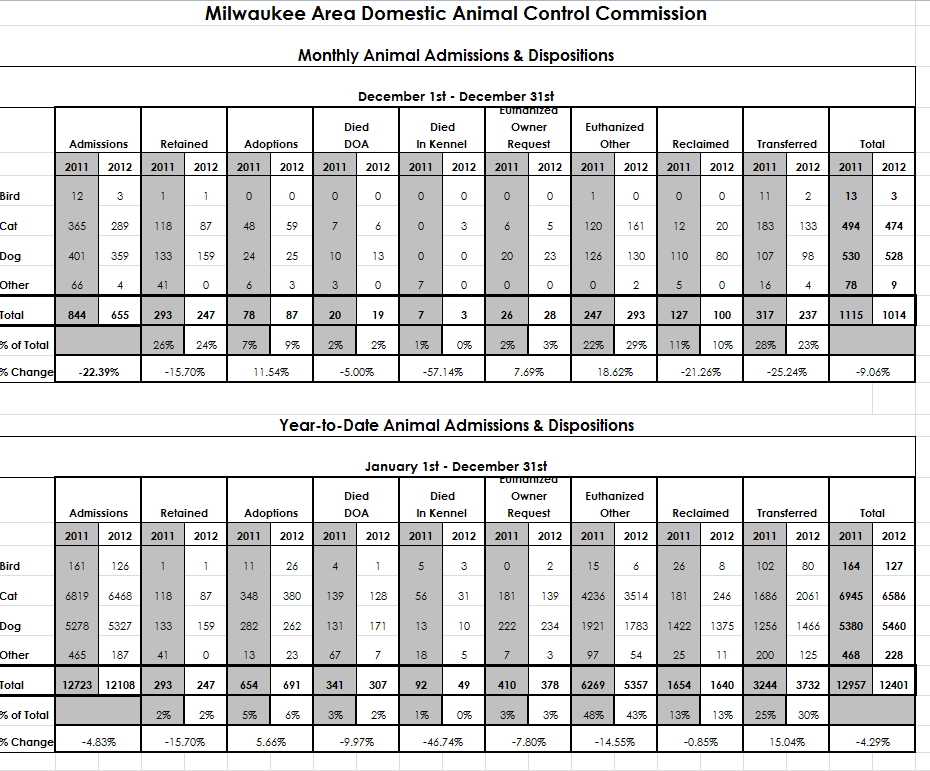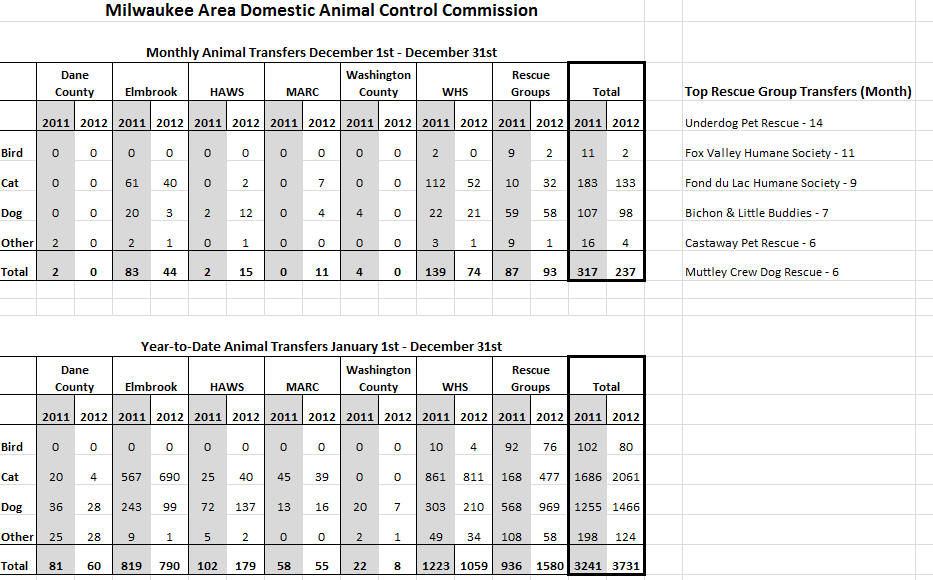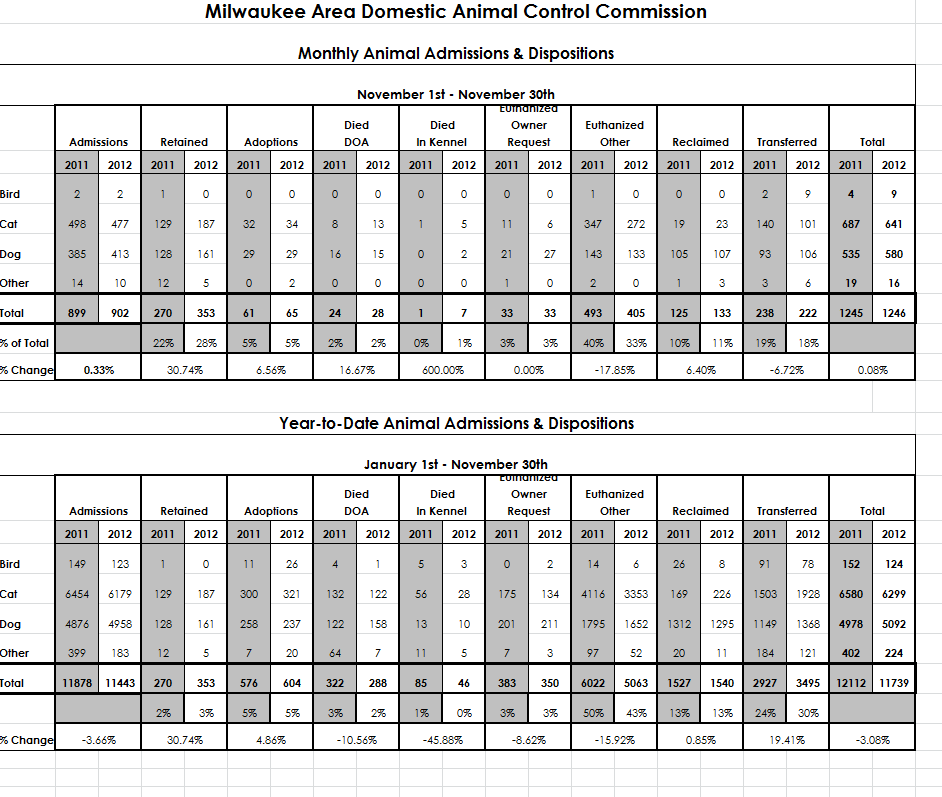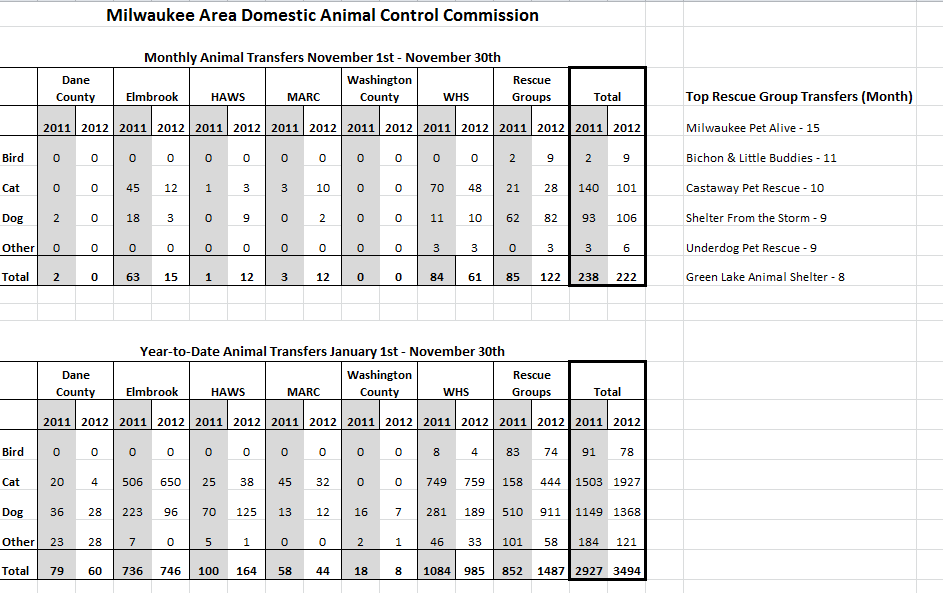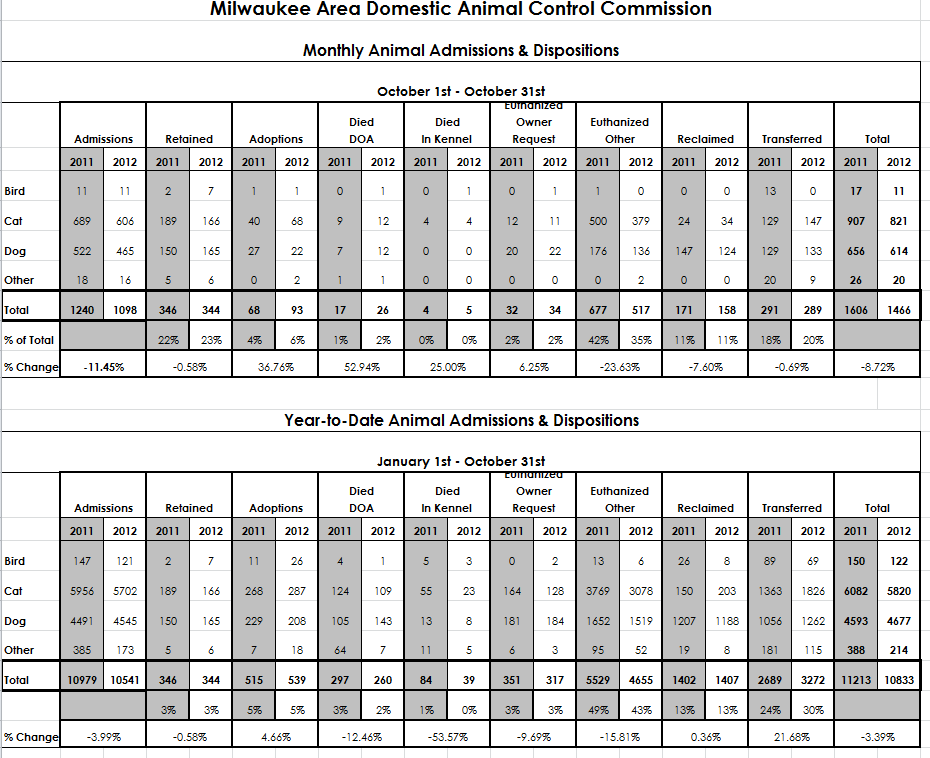|
Milwaukee Area Domestic Animal Control (MADACC) has killed 1031 animals so far in 2013. Five hundred forty three dogs, 477 cats and 11 other animals. Last year they had killed 1069 during the same period.
Intake is down for the year; but dog intake is up in April. Reclaims are down for the YTD. Transfers to other rescues and shelters are also down.
Progressive animal sheltering that saves lives relies on two things - reducing intake and increasing live outcomes.
Shelters can reduce intake by: proactively reuniting more lost pets with their families, preferably before they even reach the shelter; offering low cost spay and neuter services to the public; offering trap,neuter return programs for feral cats; and by reducing surrenders and "abandonment at the shelter" through excellent customer service and animal help desks.
Shelters can increase live outcomes by transferring animals to other rescues and shelters, offering medical and behavior rehabilitation; using volunteers to socialize, train and foster animals; and creating innovative adoption and marketing programs.
The busy summer months are ahead. More pets are outside, thereby more are lost and end up in the shelter system. Feral cats are having kittens which are often brought to animal control by Good Samaritans. If MADACC is going to succeed in reducing euthanasia by a significant amount in 2013, they will need to get on the right track quickly.
Milwaukee Area Domestic Animal Control (MADACC) has killed 747 animals so far this year through March 2013. (This does not include those that died in their kennel, were dead on arrival, or were owner-requested euthanasia).
Four hundred and four dogs, 332 cats and 11 other animals died at MADACC. The chart above shows the comparisons from last year to this year and also the breakdown of the March statistics. The new Executive Director, Karen Sparapani, started on February 16 so this is the first full month of statistics under her directorship. April statistics will not be available until after the May operations committee meeting. Intake is down (a good thing!) and so are shelter deaths. But unfortunately, reclaims and transfers are also down for the year. Progressive animal sheltering that saves lives relies on two things - reducing intake and increasing live outcomes. Shelters can reduce intake by: proactively reuniting more lost pets with their families, preferably before they even reach the shelter; offering low cost spay and neuter services; offering trap, neuter, return programs for feral cats; and by reducing surrenders and "abandonment at the shelter" through excellent customer service and animal help desks. Shelters can increase live outcomes by transferring animals to other rescues and shelters; offering medical and behavior rehabilitation; using volunteers to socialize, train and foster animals; and creating innovative adoption and marketing programs.
Wednesday, April 3, 2013
Thank you for contacting my office with your concerns regarding the staffing of the Milwaukee Area Animal Control Commission (MADACC). I appreciate your taking the time to share your thoughts with me. I am dedicated to ensuring that the animals in the City of Milwaukee are safe, healthy and cared for and I commend MADACC for providing effective and cost efficient animal control services. As you know, MADACC represents 19 municipalities in Milwaukee County and their work assures temporary shelter is available, veterinary and humane care for animals in need is prioritized and a central location for owners to find and recover their lost pets is accessible to the public. I have heard from a number of constituents who share your concerns over the future of MADACC. I want you to know that I have shared your message with the other participatory municipalities and MADACC staff. I am confident that the recently appointed Executive Director, Karen Sparapani, will demonstrate capable leadership during this transition and I urge you to welcome her perspective and continue participating in this discussion in a productive manner. Again, thank you for sharing your thoughts with me. Your concern for this issue is admirable. Please do not hesitate to contact my office with any other issues you feel merit my attention. Sincerely, Tom Barrett Mayor
(We have heard that several people received the same reply)

Senator Tim Carpenter (D) Senate District 3, announced his intention to re-introduce a bill to improve the process and outcome for seized dogs in Wisconsin. The following quote is taken from his public Facebook page "Let's end indefinte detention for dogs confiscated as court evidence for prosecutions of dog fighting or abuse. I will be re-introducing a bill to make it easier for such dogs to be rehabilitated and adopted. When a bill number is assigned, I'll post it her to allow folks to discuss this issue with their legislators. "
Senator Carpenter then referenced the WISN 12 News story that aired this week describing the plight of the Milwaukee Court Case Dogs, some which have been held in solitary confinement since June 2011. Here are the links to the news stories: Part 1: WISN 12 News investigates incarcerated dogs rescued from dog-fighting rings. Part 2: WISN 12 News' investigation of locked-up dogs prompts actions Follow the Save Milwaukee's Court Case Dogs Facebook page for more information and updates. MADACC Killed 5357 Animals in 20121/17/2013
Milwaukee Area Domestic Animal Control (MADACC) killed 5357 animals in 2012. (This does not include those that died in their kennel, were dead on arrival, or were owner-requested euthanasia).
Six birds, 3514 cats, 1783 dogs, and 54 other animals died at MADACC. The charts below show comparisons from last year to this year and also the breakdown of the December statistics. As you can see, transfers and reclaims where sharply down in December. Some improvement in overall numbers has been shown over last year but other cities in America are doing much better while Milwaukee is lagging behind. Cities such as Reno, Austin, San Antonio, Jacksonville, Salt Lake City and Kansas City, Missouri are improving their animal control programs and saving lives. The key to solving the problem is knowing that there is a problem. If you did not know that MADACC had such a high death rate for animals in Milwaukee County please share this blog post with your friends and neighbors. If you are a resident of Milwaukee County please contact your local alderman to express your displeasure. Milwaukee County animal control is funded by your tax dollars. Milwaukee Area Domestic Animal Control Commission (MADACC) Transfer Numbers - December 20121/17/2013
Do you ever wonder which shelters and rescue groups transfer the most animals out of MADACC and make them available for adoption at their own facilities? Here are the year to date through December 2012 transfer numbers. You can also compare to the transfer numbers from 2011.
Of course, there are a lot of things to be taken into consideration. One of the top-pulling rescues, Remember Me Ranch, has been "banned" from pulling dogs. Current MADACC management also makes it incredibly difficult for rescues and shelters to pull dogs. There is a serious lack of communication. They also make it difficult for BRATS, the all volunteer transport service, to facilitate the transfer. Plus, many of the dogs leaving MADACC are sick because of poor sanitation and veterinary practices. This makes shelters and rescues reluctant to "pull" because it can be very expensive to rehabilitate sick or injured dogs. There is also the risk of disease transmission to the rest of their shelter's animals. Transparency is the key to making changes for our companion animals. We must know what the problem is if we are going to try to solve it.
Milwaukee Area Domestic Animal Control (MADACC has killed 5063 animals so far this year through November 30, 2012. (This does not include those that died in their kennel, were dead on arrival, or were owner-requested euthanasia).
Six birds, 3353 cats, 1652 dogs, and 52 other animals died at MADACC. The charts below show comparisons from last year to this year and also the breakdown of the November statistics. As you can see, in November alone, MADACC killed 405 animals. Summer months are generally the busiest months for animal control, intake numbers typically decrease in the fall and winter. Especially troubling is that seven animals died in their kennel in November 2012. A 600% increase from November 2011. Some improvement in overall numbers has been shown over last November but other cities in America are doing much better while Milwaukee is lagging behind. Cities such as Reno, Austin, San Antonio, Jacksonville, Salt Lake City and Kansas City, Missouri are improving their animal control programs and saving lives. The key to solving the problem is knowing that there is a problem. If you did not know that MADACC had such a high death rate for animals in Milwaukee County please share this blog post with your friends and neighbors. If you are a resident of Milwaukee County please contact your local alderman to express your displeasure. Milwaukee County animal control is funded by your tax dollars. Milwaukee Area Domestic Animal Control Commission (MADACC) Transfer Numbers - November 201212/20/2012
Do you ever wonder which shelters and rescue groups transfer the most animals out of MADACC and make them available for adoption at their own facilities? Here are the year to date through November 2012 transfer numbers. You can also compare to the transfer numbers from 2011.
Of course, there are a lot of things to be taken into consideration. One of the top-pulling rescues, Remember Me Ranch, has been "banned" from pulling dogs. Current MADACC management also makes it incredibly difficult for rescues and shelters to pull dogs. There is a serious lack of communication. They also make it difficult for BRATS, the all volunteer transport service, to facilitate the transfer. Plus, many of the dogs leaving MADACC are sick because of poor sanitation and veterinary practices. This makes shelters and rescues reluctant to "pull" because it can be very expensive to rehabilitate sick or injured dogs. There is also the risk of disease transmission to the rest of their shelter's animals. Transparency is the key to making changes for our companion animals. We must know what the problem is if we are going to try to solve it. Wisconsin's Open Meeting Laws11/24/2012
"The State of Wisconsin recognized the importance of having a public informed about governmental affairs. The state's open meetings law declares that:
In recognition of the fact that a representative government of the American type is dependent upon an informed electorate, it is declared to be the policy of this state that the public is entitled to the fullest and most complete regarding the affairs of government as is compatible with the conduct of governmental business." The above two paragraphs are taken directly from the Compliance Guide for the Wisconsin Open Meetings Law that was written in August 2010. How does it affect animal advocacy? What does it mean for you, a concerned citizen that is speaking out for animals in your Wisconsin community? Here are a few highlights and then please follow the link above for the full guide.
This is just a brief overview of the Compliance Guide. Please refer to it for more detailed information.
Milwaukee Area Domestic Animal Control (MADACC) has killed 4655 animals this year through October 31, 2012. (This does not include those that died in their kennel, were dead on arrival, or were owner-requested euthanasia).
Six birds, 3078 cats, 1519 dogs, and 52 other animals died at MADACC. The charts below show comparisons from last year to this year and also the breakdown of the October statistics. As you can see, in October alone, MADACC killed 517 animals. Summer months are generally the busiest months for animal control, intake numbers usually decrease in the fall. Some improvement has been shown over last October but other cities in America are doing much better while Milwaukee is lagging behind. Cities such as Reno, Austin, San Antonio, Jacksonville, Salt Lake City and Kansas City, Missouri are improving their animal control programs and saving lives. The key to solving the problem is knowing that there is a problem. If you did not know that MADACC had such a high death rate for animals in Milwaukee County please share this blog post with your friends and neighbors. If you are a resident of Milwaukee County please contact your local alderman to express your displeasure. Milwaukee County animal control is funded by your tax dollars. |
Our blog will be an ongoing conversation regarding humane legislation and improved conditions for companion animals in Wisconsin. Feel free to contact us with your letters, ideas and input. wivotersforcompanionanimals @gmail.com
CategoriesAll ArchivesNovember 2020  RSS Feed RSS Feed
Authors
|
| Wisconsin Voters For Companion Animals |
|
